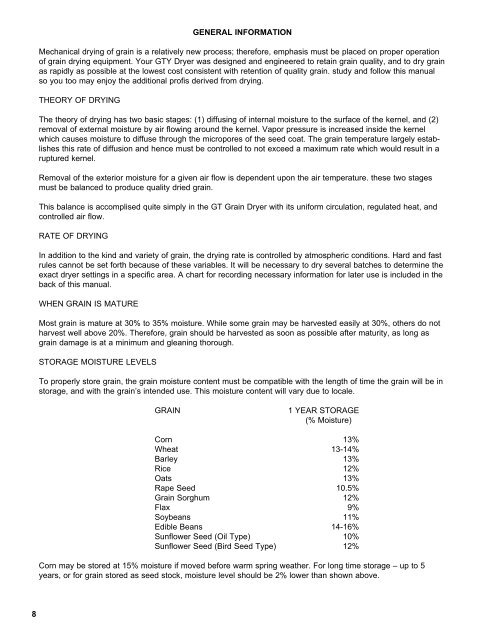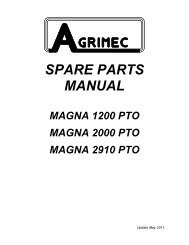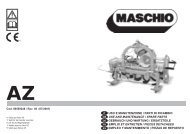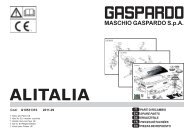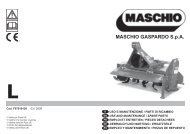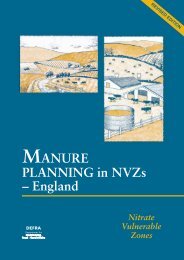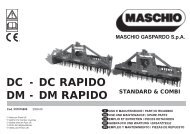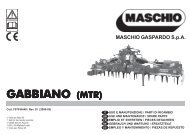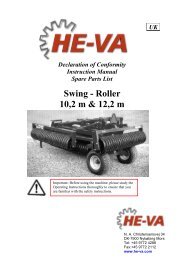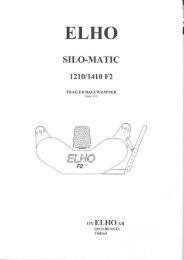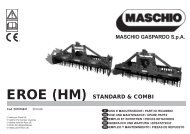GRAIN DRYER & PARTS BOOK - Opico
GRAIN DRYER & PARTS BOOK - Opico
GRAIN DRYER & PARTS BOOK - Opico
You also want an ePaper? Increase the reach of your titles
YUMPU automatically turns print PDFs into web optimized ePapers that Google loves.
GENERAL INFORMATION<br />
Mechanical drying of grain is a relatively new process; therefore, emphasis must be placed on proper operation<br />
of grain drying equipment. Your GTY Dryer was designed and engineered to retain grain quality, and to dry grain<br />
as rapidly as possible at the lowest cost consistent with retention of quality grain. study and follow this manual<br />
so you too may enjoy the additional profis derived from drying.<br />
THEORY OF DRYING<br />
The theory of drying has two basic stages: (1) diffusing of internal moisture to the surface of the kernel, and (2)<br />
removal of external moisture by air flowing around the kernel. Vapor pressure is increased inside the kernel<br />
which causes moisture to diffuse through the micropores of the seed coat. The grain temperature largely establishes<br />
this rate of diffusion and hence must be controlled to not exceed a maximum rate which would result in a<br />
ruptured kernel.<br />
Removal of the exterior moisture for a given air flow is dependent upon the air temperature. these two stages<br />
must be balanced to produce quality dried grain.<br />
This balance is accomplised quite simply in the GT Grain Dryer with its uniform circulation, regulated heat, and<br />
controlled air flow.<br />
RATE OF DRYING<br />
In addition to the kind and variety of grain, the drying rate is controlled by atmospheric conditions. Hard and fast<br />
rules cannot be set forth because of these variables. It will be necessary to dry several batches to determine the<br />
exact dryer settings in a specific area. A chart for recording necessary information for later use is included in the<br />
back of this manual.<br />
WHEN <strong>GRAIN</strong> IS MATURE<br />
Most grain is mature at 30% to 35% moisture. While some grain may be harvested easily at 30%, others do not<br />
harvest well above 20%. Therefore, grain should be harvested as soon as possible after maturity, as long as<br />
grain damage is at a minimum and gleaning thorough.<br />
STORAGE MOISTURE LEVELS<br />
To properly store grain, the grain moisture content must be compatible with the length of time the grain will be in<br />
storage, and with the grain’s intended use. This moisture content will vary due to locale.<br />
<strong>GRAIN</strong><br />
1 YEAR STORAGE<br />
(% Moisture)<br />
Corn 13%<br />
Wheat 13-14%<br />
Barley 13%<br />
Rice 12%<br />
Oats 13%<br />
Rape Seed 10.5%<br />
Grain Sorghum 12%<br />
Flax 9%<br />
Soybeans 11%<br />
Edible Beans 14-16%<br />
Sunflower Seed (Oil Type) 10%<br />
Sunflower Seed (Bird Seed Type) 12%<br />
Corn may be stored at 15% moisture if moved before warm spring weather. For long time storage – up to 5<br />
years, or for grain stored as seed stock, moisture level should be 2% lower than shown above.<br />
8


